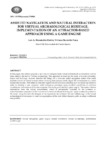Assisted navigation and natural interaction for virtual archaeological heritage. Implementation of an attractor-based approach using a game engine

Use this link to cite
http://hdl.handle.net/2183/35368Collections
- Investigación (ETSECCP) [826]
Metadata
Show full item recordTitle
Assisted navigation and natural interaction for virtual archaeological heritage. Implementation of an attractor-based approach using a game engineDate
2016Citation
Hernández-Ibáñez, L. A. & Barneche-Naya, V. (2016). Assisted navigation and natural interaction for virtual archaeological heritage. Implementation of an attractor-based approach using a game engine. Mediterranean Archaeology and Archaeometry, 16 (5), 43-51.
Abstract
[Abstract]: In this paper, the authors propose a new way to navigate inside virtual architectural environments such as those used in the field of Virtual Archaeology. This approach is based on the study of human movement inside real buildings. Authors describe the design of a computer aided navigation system that could facilitate visitors of virtual reconstructions in taking their journey inside digital 3D environments in a more human-like manner. This research considers aspects related to human attention and non-linear narratives in order to develop a new computer aided navigation paradigm using excellent capabilities of real-time visualisation, interaction and human-computer interfacing provided by a game engine. This system obtains information from the virtual environment, which is perceptually enriched by the presence of metainformation associated to the importance in terms of interest of every part, space or element present in the scene. Using this tool, the designer of the experience can influence the user walkthrough in the virtual archaeological environment to meet the expectations of the visit, follow thematic paths or adapt to different user profiles.
Keywords
Virtual navigation
Game engine
Human movement
Virtual archaeology
Architectural walkthrough
Game engine
Human movement
Virtual archaeology
Architectural walkthrough
Editor version
Rights
Atribución 3.0 España Creative Commons Attribution License (CC BY)
ISSN
1108-9628
2241-8121
2241-8121






